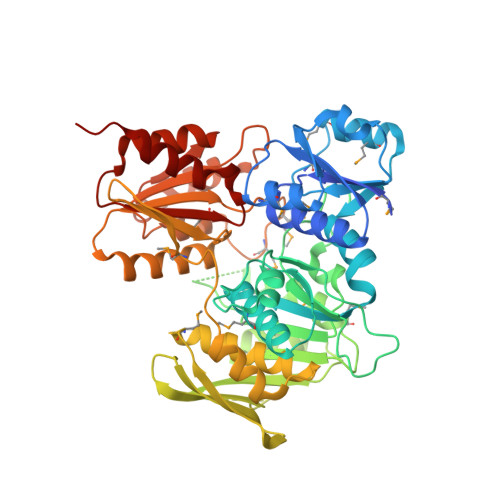Structure and function of the first full-length murein Peptide ligase (mpl) cell wall recycling protein.
Das, D., Herve, M., Feuerhelm, J., Farr, C.L., Chiu, H.J., Elsliger, M.A., Knuth, M.W., Klock, H.E., Miller, M.D., Godzik, A., Lesley, S.A., Deacon, A.M., Mengin-Lecreulx, D., Wilson, I.A.(2011) PLoS One 6: e17624-e17624
- PubMed: 21445265
- DOI: https://doi.org/10.1371/journal.pone.0017624
- Primary Citation of Related Structures:
3HN7 - PubMed Abstract:
Bacterial cell walls contain peptidoglycan, an essential polymer made by enzymes in the Mur pathway. These proteins are specific to bacteria, which make them targets for drug discovery. MurC, MurD, MurE and MurF catalyze the synthesis of the peptidoglycan precursor UDP-N-acetylmuramoyl-L-alanyl-γ-D-glutamyl-meso-diaminopimelyl-D-alanyl-D-alanine by the sequential addition of amino acids onto UDP-N-acetylmuramic acid (UDP-MurNAc). MurC-F enzymes have been extensively studied by biochemistry and X-ray crystallography. In gram-negative bacteria, ∼30-60% of the bacterial cell wall is recycled during each generation. Part of this recycling process involves the murein peptide ligase (Mpl), which attaches the breakdown product, the tripeptide L-alanyl-γ-D-glutamyl-meso-diaminopimelate, to UDP-MurNAc. We present the crystal structure at 1.65 Å resolution of a full-length Mpl from the permafrost bacterium Psychrobacter arcticus 273-4 (PaMpl). Although the Mpl structure has similarities to Mur enzymes, it has unique sequence and structure features that are likely related to its role in cell wall recycling, a function that differentiates it from the MurC-F enzymes. We have analyzed the sequence-structure relationships that are unique to Mpl proteins and compared them to MurC-F ligases. We have also characterized the biochemical properties of this enzyme (optimal temperature, pH and magnesium binding profiles and kinetic parameters). Although the structure does not contain any bound substrates, we have identified ∼30 residues that are likely to be important for recognition of the tripeptide and UDP-MurNAc substrates, as well as features that are unique to Psychrobacter Mpl proteins. These results provide the basis for future mutational studies for more extensive function characterization of the Mpl sequence-structure relationships.
- Stanford Synchrotron Radiation Lightsource, SLAC National Accelerator Laboratory, Menlo Park, California, United States of America.
Organizational Affiliation:

















